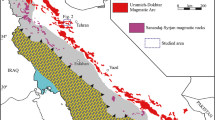Abstract
Alkaline-basic dike from the Yllymakh Massif (Central Aldan) has been studied. Its partially crystallized matrix contains corroded phenocrysts of olivine and hypidiomorphic phenocrysts of clinopyroxene and pseudo-, epileucite. It was found that phenocrysts of clinopyroxene contain abundant primary inclusions, Ti-magnetite and apatite bear only single inclusions, whereas olivine is enriched in secondary inclusions, which are confined to the cleavage of host mineral (along second and third pinacoids) and its cracks. The homogenization temperatures of the primary inclusions in clinopyroxene and secondary inclusions in olivine are approximately equal and lie within 1260–1240°C. The compositions of melt inclusions in olivine and clinopyroxene are also similar and corresponded to the malignite-pseudoleucite phonolite-monzonite pulaskites, which are developed at the Yllymakh Massif. Unheated inclusions in apatite and Ti-magnetite compositionally approach monzonites and nepheline syenites—tinguaites, respectively. It was concluded that the alkaline basaltoid magma was presumably parental magma for the entire rock complex of the Yllymakh Massif. Its crystallization and differentiation presumably provided all observed rock variety from ultrabasics (early derivatives located at depth) and malignites (later derivatives) to leucite phonolites, monzonites, and alkaline pulaskites, which were obtained during subsequent stages of the melt evolution. The parental magma, and especially its derivatives, were enriched in BaO (0.8–0.1 wt %), Cl (0.1–0.3 wt %) and trace elements (primarily, LREE and MREE), which are several times higher than mantle values. At the same time, ion microprobe (SIMS) study showed that derivative melts were dry: contained only 0.01–1.13 wt % H2O. The trend of melts conserved in the minerals and the massif rocks corresponds to the evolution of alkalinebasaltoid magma with increase in Si, Al, alkalis and decrease in Mg, Ca, and Fe, i.e. the Bowen trend. The considered alkaline-basic dike was presumably formed from the derivative of leucite-phonolite melt, which during emplacement captured olivine xenocrysts from previously fractionated ultrabasic rocks. The parental magma was presumably derived by high-degree melting of garnet-spinel-facies depleted mantle at some influence of crustal material.
Similar content being viewed by others
References
A. I. Chepurov, “Thermometric Study of Melt Inclusions in the Minerals of Pseudoleucitite (Central Aldan),” Dokl. Akad. Nauk SSSR, No. 2, 437–440 (1974).
T. Yu. Bazarova, I. T. Bakumenko, V. P. Kostyuk, L. I. Panina, et al., Magmatogenic Crystallization Based on Melt Inclusion Data (Nauka, Novosibirsk, 1975) [in Russian].
L. I. Panina, “Lamproite Rocks of Aldan and Genetic Criteria of Lamproite Melt,” Geol. Geofiz., No. 6, 82–89 (1993).
L. I. Panina and A. A. Konev, “Genetic Peculiarities of the Formation of Lamproites from the Molbo River, Western Aldan,” Geokhimiya, No. 3, 366–376 (1995).
Yu. A. Bilibin, Petrology of the Yllymakh Intrusion (Gos. geol. izd-vo, Moscow, 1947) [in Russian].
S. M. Kravchenko and S. V. Vlasova, Alkaline Rocks of Central Aldan (Nauka, Moscow, 1962) [in Russian].
G. K. Shnai and M. P. Orlova, “New Data on Geology and Ore Potential of the Yllymakh Massif,” Geol. Geofiz., No. 10, 57–65 (1977).
A. A. El’yanov and V. M. Moralev, “To the Problem of Deep Structure of the Yllymakh Volcanoplutonic Complex, Central Aldan Area,” Izv. Akad. Nauk SSSR, Ser. Geol., No. 1, 134–137 (1974).
M. Yu. Mikhailov and V. S. Shatskii, “A Silite Furnace for High-Temperature Microthermostage,” in Mineralogy of Endogenous Rocks (Nauka, Novosibirsk, 1974), pp. 109–110 [in Russian].
N. Yu. Osorgin and A. A. Tomilenko, Mikroheating Stage, USSR’s Inventor Certificate No. 1562816, 1990.
A. V. Sobolev and V. G. Batanova, “Mantle Lherzollites of the Troodos Ophiolite Complex, Cyprus Island: Geochemistry of Clinopyroxene,” Petrologiya 3(5), 487–495 (1995).
N. L. Dobretsov, Yu. N. Kochkin, A. P. Krivenko, and V. A. Kutolin, Rock-Forming Pyroxenes (Nauka, Moscow, 1971) [in Russian].
A. V. Sobolev, V. S. Kamenetskii, and N. N. Kononkova, “New Data on the Petrology of the Siberian Meimechites,” Geokhimiya, No. 8, 1084–1095 (1991).
A. V. Sobolev and A. B. Slutskii, “Compositions and Conditions of Crystallization of Parental Melts for the Siberian Meimechites and Relation with A General Problem of Ultrabasic Magmas,” Geol. Geofiz., No. 12, 97–110 (1984).
A. V. Sobolev and L. V. Danyushevsky, “Petrology and Geochemistry of Boninites from the North Termination of the Tonga Trench: Constraints on the Generation Conditions of Primary High-Ca Boninite Magmas,” J. Petrol. 35(5), 1183–1211 (1994).
S. R. Taylor and S. M. McLennan, The Continental Crust: Its Composition and Evolution (Blackwell, Oxford, 1985).
Yu. A. Balashov, Geochemistry of the Rare Earth Elements (Nauka, Moscow, 1972) [in Russian].
F. P. Lesnov, “Tendencies in the Rare Earth Element Distribution in Olivines,” Zap. Vseross. Mineral. O-va, No. 6, 88–102 (2000).
N. M. Evensen, P. I. Hamilton, and R. K. O’ Nions, “Rare Earth Abundances in Chondritic Meteorites,” Geochim. Cosmochim. Acta 42, 1199–1212 (1978).
V. P. Kostyuk, L. I. Panina, A. Ya. Zhidkov, et al., Potassic Alkaline Magmatism of the Baikal-Stanovoy Riftogenic System (Nauka, Novosibirsk, 1990) [in Russian].
M. G. Barth, W. F. McDonough, and R. L. Rudnik, “Tracing the Budget of Nb and Ta in the Continental Crust,” Chem. Geol. 165, 197–213 (2000).
Author information
Authors and Affiliations
Corresponding author
Additional information
Original Russian Text © L.I. Panina, A.T. Nikolaeva, E.Yu. Rokosova, 2011, published in Geokhimiya, 2011, Vol. 49, No. 2, pp. 129–148.
Rights and permissions
About this article
Cite this article
Panina, L.I., Nikolaeva, A.T. & Rokosova, E.Y. Crystallization conditions of the alkaline-basic dike from the Yllymakh Massif, Central Aldan: Evidence from melt inclusion data in minerals. Geochem. Int. 49, 120–138 (2011). https://doi.org/10.1134/S001670291102008X
Received:
Published:
Issue Date:
DOI: https://doi.org/10.1134/S001670291102008X




